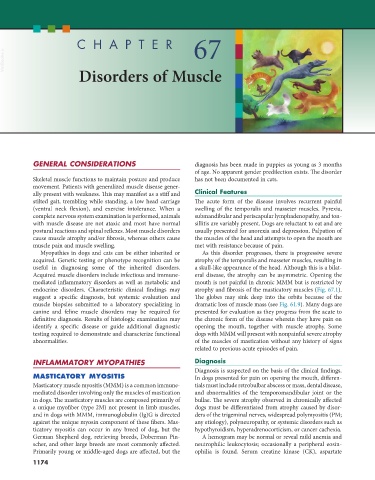Page 1202 - Small Animal Internal Medicine, 6th Edition
P. 1202
1174 PART IX Nervous System and Neuromuscular Disorders
CHAPTER 67
VetBooks.ir
Disorders of Muscle
GENERAL CONSIDERATIONS diagnosis has been made in puppies as young as 3 months
of age. No apparent gender predilection exists. The disorder
Skeletal muscle functions to maintain posture and produce has not been documented in cats.
movement. Patients with generalized muscle disease gener-
ally present with weakness. This may manifest as a stiff and Clinical Features
stilted gait, trembling while standing, a low head carriage The acute form of the disease involves recurrent painful
(ventral neck flexion), and exercise intolerance. When a swelling of the temporalis and masseter muscles. Pyrexia,
complete nervous system examination is performed, animals submandibular and periscapular lymphadenopathy, and ton-
with muscle disease are not ataxic and most have normal sillitis are variably present. Dogs are reluctant to eat and are
postural reactions and spinal reflexes. Most muscle disorders usually presented for anorexia and depression. Palpation of
cause muscle atrophy and/or fibrosis, whereas others cause the muscles of the head and attempts to open the mouth are
muscle pain and muscle swelling. met with resistance because of pain.
Myopathies in dogs and cats can be either inherited or As this disorder progresses, there is progressive severe
acquired. Genetic testing or phenotype recognition can be atrophy of the temporalis and masseter muscles, resulting in
useful in diagnosing some of the inherited disorders. a skull-like appearance of the head. Although this is a bilat-
Acquired muscle disorders include infectious and immune- eral disease, the atrophy can be asymmetric. Opening the
mediated inflammatory disorders as well as metabolic and mouth is not painful in chronic MMM but is restricted by
endocrine disorders. Characteristic clinical findings may atrophy and fibrosis of the masticatory muscles (Fig. 67.1).
suggest a specific diagnosis, but systemic evaluation and The globes may sink deep into the orbits because of the
muscle biopsies submitted to a laboratory specializing in dramatic loss of muscle mass (see Fig. 61.9). Many dogs are
canine and feline muscle disorders may be required for presented for evaluation as they progress from the acute to
definitive diagnosis. Results of histologic examination may the chronic form of the disease wherein they have pain on
identify a specific disease or guide additional diagnostic opening the mouth, together with muscle atrophy. Some
testing required to demonstrate and characterize functional dogs with MMM will present with nonpainful severe atrophy
abnormalities. of the muscles of mastication without any history of signs
related to previous acute episodes of pain.
INFLAMMATORY MYOPATHIES Diagnosis
Diagnosis is suspected on the basis of the clinical findings.
MASTICATORY MYOSITIS In dogs presented for pain on opening the mouth, differen-
Masticatory muscle myositis (MMM) is a common immune- tials must include retrobulbar abscess or mass, dental disease,
mediated disorder involving only the muscles of mastication and abnormalities of the temporomandibular joint or the
in dogs. The masticatory muscles are composed primarily of bullae. The severe atrophy observed in chronically affected
a unique myofiber (type 2M) not present in limb muscles, dogs must be differentiated from atrophy caused by disor-
and in dogs with MMM, immunoglobulin (Ig)G is directed ders of the trigeminal nerves, widespread polymyositis (PM;
against the unique myosin component of these fibers. Mas- any etiology), polyneuropathy, or systemic disorders such as
ticatory myositis can occur in any breed of dog, but the hypothyroidism, hyperadrenocorticism, or cancer cachexia.
German Shepherd dog, retrieving breeds, Doberman Pin- A hemogram may be normal or reveal mild anemia and
scher, and other large breeds are most commonly affected. neutrophilic leukocytosis; occasionally a peripheral eosin-
Primarily young or middle-aged dogs are affected, but the ophilia is found. Serum creatine kinase (CK), aspartate
1174

